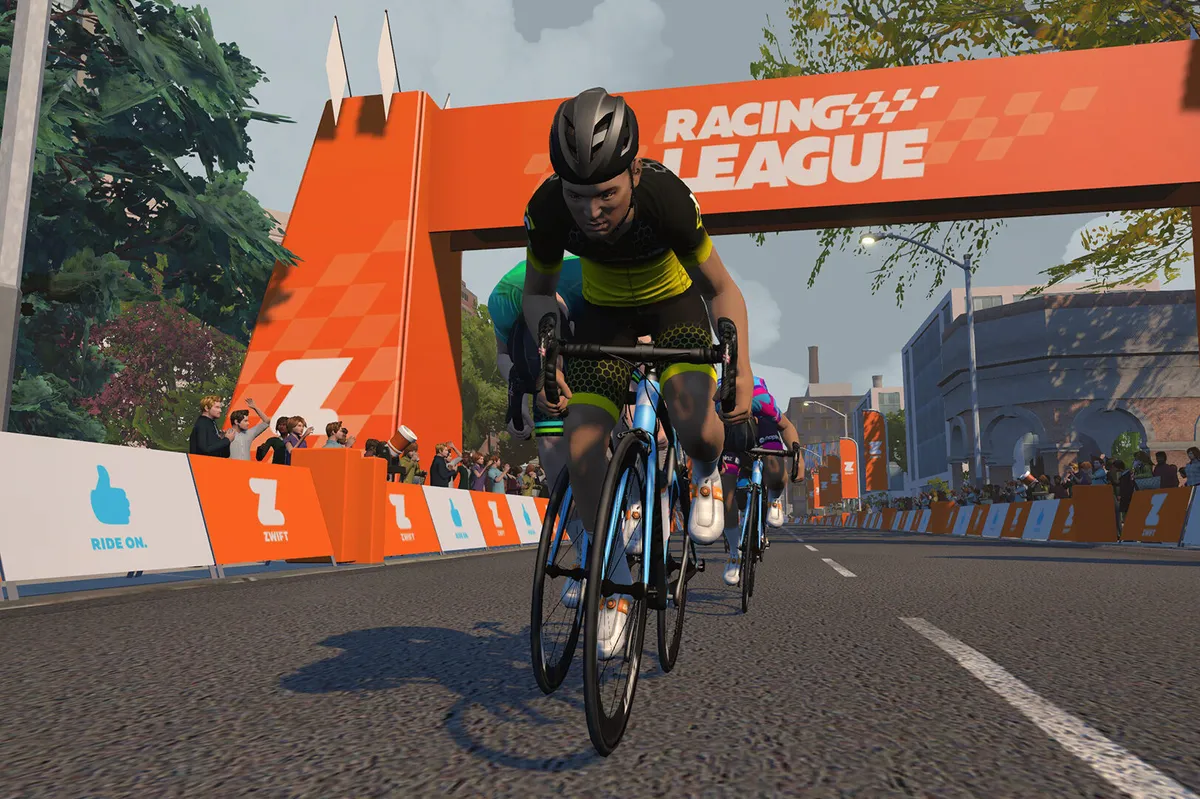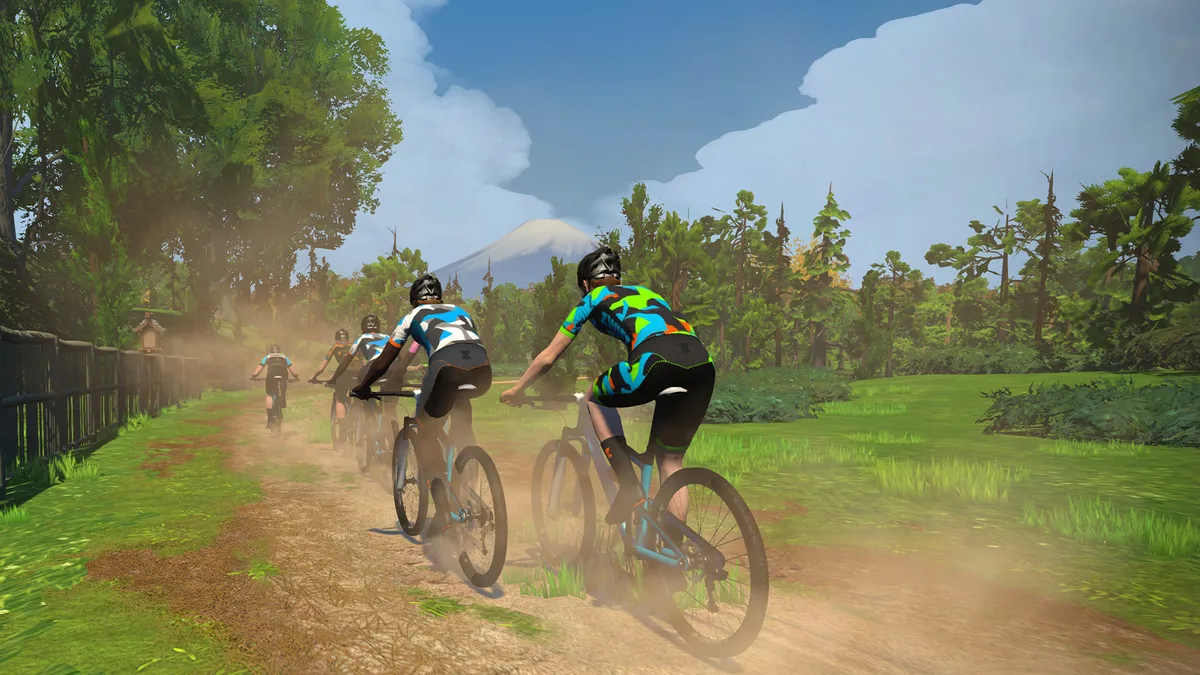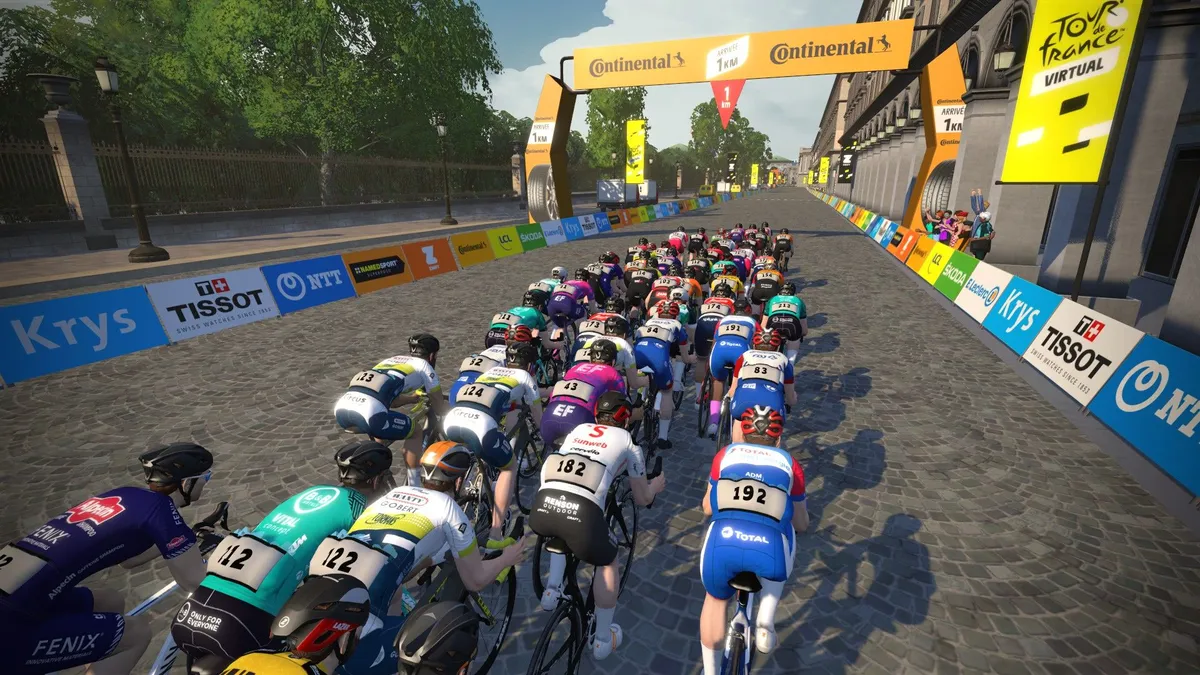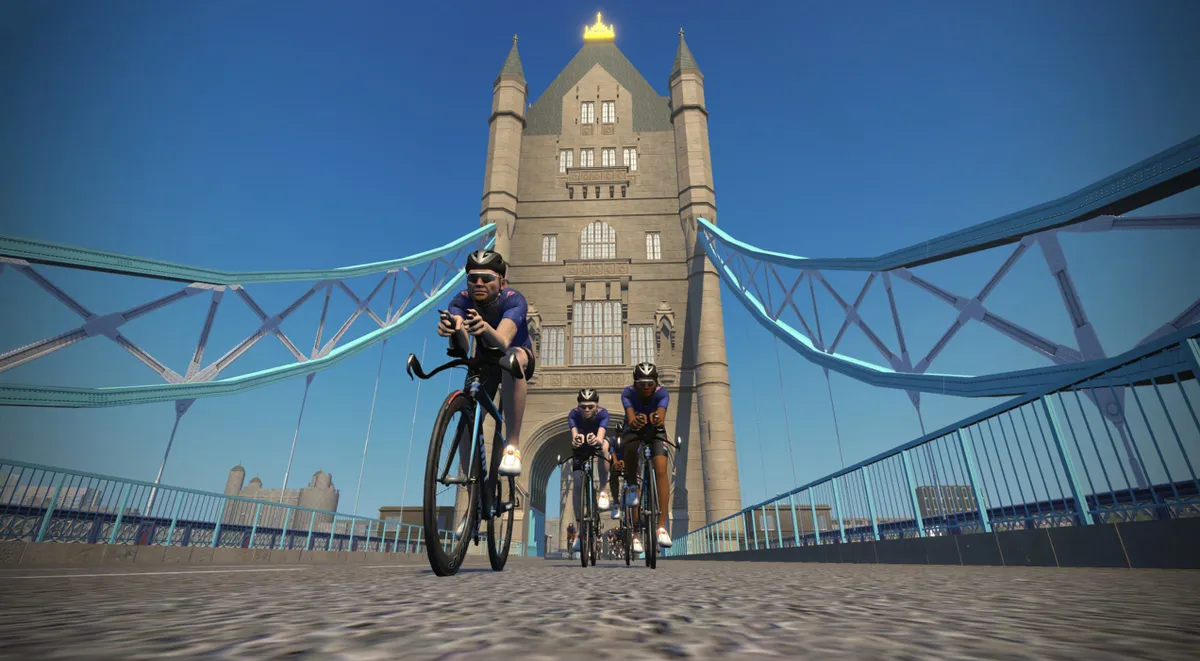Whether you’re training for an event or want to tear the legs off your riding buddies in the virtual world, as well as the real world, racing on Zwift is a great way to compete, train and have fun on your bike.
Zwift racing is one of the newest forms of bike racing, and if you’ve not yet taken the plunge, you could be missing out – not only on some great training but also on a lot of fun.
If you’ve invested in a smart trainer, racing on Zwift is one of the best ways to get the most out of your new toy because it enables you to compete against other like-minded cyclists from all over the world, whenever suits you, and from the comfort of your own home.
And while a Corinthian spirit might be admirable, it’s not all just fun and games – virtual racing can be a serious business, for pros and amateurs alike.
The annual Zwift Academy competition is open to all and offers a pro contract to the winners. Past winners who have gone on to a successful pro career include Neve Bradbury and Jay Vine.
So how can you get involved? And what do you need to get started? We’re here to help. And if you’re completely new to Zwift and wondering what it’s all about, don’t forget to check out our in-depth Zwift guide.
What you need to get started

Before you can start racing, you’ll need to sign up for a Zwift account, if you don’t already have one.
You can get a free 14-day trial if you register for a Zwift account online, but after your trial period ends it costs £17.99 / $19.99 (plus sales tax) per month to continue using it. You can also purchase an annual membership for £179.99 / $199.99 (plus sales tax) with a 30-day money-back guarantee.
There are a few things specific to racing, beyond the standard turbo trainer accessories, that you’ll want to ensure you have in place before you jump into a race.
You can race online using any Zwift setup, from a budget turbo trainer to the ultimate indoor smart bike, but for the best experience, you ideally need to use a smart trainer, such as the Wahoo Kickr Core Zwift One.
You can add Zwift Ride for a complete indoor bike, which enables you to leave your outdoor bike outdoors.

If you only have a classic-style ‘dumb’ trainer, you can use an on-bike power meter to race, but you’ll miss out on simulated gradients, which are a key aspect of creating an immersive experience.
Just as in the real world, the most important thing before you step on the (virtual) start line is to ensure you’re prepared for the entire duration of the race (races tend to last between 20 and 40 minutes).
Once the race starts, there's no chance to stop to fill your water bottle, turn up your fan or grab a towel.
So, make sure you’ve got two full bottles (consider filling one with water and the other with a sports drink), your towel is within reach, your fan is set up correctly and all of your devices are plugged in to their chargers.
How to find a race on Zwift

Races in Zwift are classified as events, so the easiest way to find them is on the Events page in-game or in the Zwift Companion app.
You can then filter events according to what kind of race and category (more on this later) you’re looking to enter. Once you’ve found a race you like the look of, tap the plus icon next to your category to enter.
Before signing up, read the description carefully because each race can have slightly different rules, and you risk getting disqualified from the results if you break any of them.
Consider signing up for a ZwiftPower account to keep track of your results and race performances. Once you’ve done that, you can link it to your Zwift account via the connections page of your profile on my.zwift.com.
What races are there?

Community events
Most races on Zwift are put on by community event organisers – just like the real-world heroes who stand by the side of the road in a hi-vis jacket volunteering at local road races and time trials.
With dozens of races every day, you’re sure to find one that works for you.
ZRacing Monthly Series
The ZRacing Monthly Series is a way for individual riders to compete in a series-based event year-round.
It’s designed to cater for all levels of rider, whether you’re racing competitively or looking to build up your fitness, and features one stage a week through the month. Races take place hourly every day, so you can find a time convenient to you, in order to complete the week’s stage.
Races last between 30 and 40 minutes, and results are available at zwiftpower.com. Riders can also compete for an overall position in each month's global general classification on ZwiftPower.
- Read more on the ZRacing Monthly Series
Zwift Club
Zwift Clubs enable you to connect with like-minded Zwifters. They include events of your preferred type on your favourite kind of course, such as time trials, crits and hilly races.
Women's Racing Series
The Women's Racing Series offers around 10 events each week, run by different community teams. There are races for beginners, scratch races, mini-races and more.
There's also an annual Zwift series of women-only races. You can find a list of events here.
Zwift Racing League

Some community events have grown into large and sophisticated organisations, such as the WTRL (World Tactical Racing Leagues).
Having made a name for itself with a weekly time trial race series, WTRL entered into an official partnership with Zwift to coordinate the team-based Zwift Racing League.
The Zwift Racing League includes five continental-based leagues with more than 120 divisions and 1,800 teams, racing across 22 time zones and attracting more than 35,000 racers each season.
The series features three rounds of six weeks, with races every Tuesday, culminating in a three-week season finale.
Rounds usually span these periods each season:
- Round 1: September to October
- Round 2: November to December
- Round 3: January to February
- Season finale: March/April
You can’t race in the Zwift Racing League alone, but it’s a great way to buddy up for a virtual team event.
Scoring is devised to reward teams who can divide roles and responsibilities between the various segments (climbs and sprints) across each course, as well as the final position across the finish line.
What better way to stay motivated than a regular race with your pals?
- Read more about the Zwift Racing League
Zwift World Series
The Zwift World Series is Zwift's star racing series. It includes a race each month for five months. There's open qualification for the Elite Series as well as the Community Series, which runs on the same course.
There's (real) prize money for Elite Series events and the top 50 riders earn a spot at the Zwift Games – the only way to participate. There's more info in the Zwift World Series Race Book.
Zwift Games
This brings us to the Zwift Games, the pinnacle of racing on Zwift, which takes place in March each year. There are Elite and Community race series, with five races on five new racing routes, including Sprint, Climb and Epic events.
Again, there's a significant prize pot for both stage and GC winners, which attracts the top global esports competitors.
Zwift Racing Score: how to pick which race to enter

Similar to how bike races in the real world are organised, Zwift races are split into categories to make each one more of a fair fight.
In 2024, Zwift introduced Zwift Racing Score.
This score classifies you based on your power numbers initially, but also rewards participation and placings in races.
Your Zwift Racing Score is a number between 0 and 1,000. As you race, your Zwift Racing Score can go up or down.
You can join races at a category above your current level, but can't join one at a lower category, which helps ensure you're racing against riders of a similar level to you.
Some events continue to use the legacy A-D category system. These events can be located easily by applying filters in the Zwift Companion app.
Zwift has a helpful FAQ if you're unsure how the rules apply to you.
If you want to move up a category, it could be worth signing up for a Zwift training plan, because these are a great way to make a big leap in fitness.
There's even one designed specifically to prepare you for the rigours of Zwift racing, called… Zwift Racing.
Designed by professional coach Shayne Gaffney, it comprises around four hours of riding per week, over four to six weeks, and has been tailored to put you in peak racing form by the end of the training plan.
What is category enforcement?

Zwift introduced category enforcement in 2022, to ensure riders are placed automatically in the most appropriate category for a race.
“Category enforcement creates a fairer environment by preventing a Zwifter from joining a category that would be too easy for them based on their current Racing Score", says Zwift.
Armed with this data, Zwift restricts riders to a minimum category when entering a race.
The lowest category visible is likely the best fit based on your Racing Score, but you can still select a more difficult category if you want a challenge.
The Zwift Racing Score system features five standard categories. Each is based on score ranges that group riders into competitive tiers according to their racing performance and power output.
To keep races enjoyable and challenging, these categories may be adjusted over time. Additionally, community event organisers can customise category ranges to suit their specific events and participants.
The Zwift Companion app now displays icons next to races with specific restrictions set by organisers, ensuring a competitive environment for riders of all levels. If an event has rules enabled, one or more of the following icons will appear:
- Event rules
- Heart-rate monitor required
- Power meter required
- Women-only events
- Steering required
These indicators help users quickly identify events that match their equipment, preferences and eligibility.
As above, some events continue to use the legacy A to D category system.
Zwift racing tips: eight ways to become a virtual-racing supremo
1. Do your homework
Knowing the course is a key component of success in Zwift racing.
There are short crit races that favour sprinting, speed on the flats and repeated efforts well above FTP, but there are also hilly races that take in lumpier routes, such as the Volcano Climb, or on occasions, the Epic KOM.
Knowing when the attacks are likely to come, or where to attack if you’re feeling strong, can be the difference between getting dropped, staying in the bunch or blowing the race to bits with your race-winning move.
Just like in the real world, moving up to the front of the bunch before the start of a climb is a great trick to give yourself a greater chance of staying with the group.
If you’re sitting at the back, you’ll have no choice but to hold the wheel in front when the pace rises, but if you start at the front you can drift back through the pack and get a draft on every wheel in the group.
Zwift races will typically surge at the bottom of the climb as everyone fights for position, so be prepared to make an early effort.
Sitting too far back in the bunch also puts you at risk of missing an important move. When the going gets tough, riders will start to leave gaps, meaning you’ll have to make surges to try to bridge to the group in front.
2. Horse for the course

Don’t forget to optimise your bike setup for the course – the bike you choose will have a bearing on your performance, depending on the demands of the terrain.
If you’re racing a flat course, forget about weight and focus on aerodynamics, but if there’s a huge climb on the course you might be better served with a lightweight setup.
It's also worth paying close attention to the type of surface you'll be riding on. Gravel and mountain bikes are much faster on the dirt roads of the Jungle Circuit in Watopia, for example.
You'll need to make the calculation (as the great Sean Kelly would say) as to whether or not you'll be better off on a road bike overall, though, if those roads only form part of the total course for the event.
And before anyone thinks it might be worth riding a TT bike on the flat courses, don’t forget you can’t draft other riders when using one of Zwift’s time-trial setups (outside of ZRL or WTRL team time trial race events), so it’s going to leave you at a significant disadvantage.
3. Full gas from the gun
If you’ve never done a Zwift race before, it’s hard to grasp exactly how hard the first few minutes of the race can be.
Get the game loaded up with plenty of time to spare and get in a good warm-up.
Your avatar will be transported automatically to the start of the race course a few minutes before the start time, but if you want a place at the front of the pack (you really do), then get set up and join the event as early as possible (start pens open 30 minutes before the race).
Once you’re in the race pen, keep spinning your legs and start pushing some big watts just before the start gun, so you don’t miss the jump.
If it’s a big race and you miss the initial sprint off the line, you’ll end up at the back of the pack and it will be very, very hard to move up to the front. The most likely outcome is someone in front of you will lose the wheel and your entire group will get shelled. Game over.
Instead, dig deep into your suitcase of courage and hold that wheel in front. Like cyclocross or criterium racing, the effort will probably be way above your FTP for the first few moments, but it will eventually settle down to a more sustainable level.
And remember, if you’re hurting, everyone else will be, too.
4. Surf the wheels

Remember to pay close attention to your draft status as well. When you’re in the draft, your avatar will sit up and put their hands on the hoods, but when you’re not, they’ll move into the drops. Zwift will also helpfully flash up a 'close the gap' graphic on-screen when you're between two and five metres from the wheel in front.
Cycling in a group saves you around 25 per cent of the effort of riding solo, so let everyone else burn themselves out before you attack. As former world champion and Classics legend Hennie Kuiper said, “Racing is licking your opponent's plate clean before starting on your own."
You'll also want to keep an eye on the 'Zwifters nearby' list, on the right-hand side of the screen. It shows the W/kg each rider is putting out, and if the numbers turn red that likely indicates someone is attacking. You'll need to react quickly if you don't plan on letting them go up the road.
5. Get aero
Did you know that you can do a ‘supertuck’ on descents?
If you stop pedalling while going fast enough on a steep descent, your avatar will sit on the top tube to coast downhill in a more aero position, helping you stay in the pack while getting a little rest.
6. PowerUps
When you’re ready to attack, make good use of PowerUps.
We’ve covered PowerUps in more detail in our Zwift guide, but using them in the right place and at the right time can be a game-changer.
Saving a Helmet Aero Boost (which reduces your avatar’s aerodynamic drag by 25 per cent for 15 seconds) for the sprint to the finish, for example, could be the difference between a good result and finishing in the middle of the pack.
The Feather Lightweight PowerUp, on the other hand, reduces your avatar’s weight by a whopping 9kg for 15 seconds, so is best used to attack on a steep climb.
To activate a PowerUp, you just need to hit the spacebar on your computer, or the on-screen PowerUp icon in the Zwift Companion app.
7. Extra tech
If you have access to a heart rate monitor, it's worth using it, because many race organisers use this data to analyse how hard riders are working and thereby detect cheats.
Similarly, if you have an on-bike power meter in addition to your smart trainer, recording data from that on a separate device, such as a bike computer, is another useful way to 'prove' your numbers are correct, if the need ever arises.
Of course, no one ever wants to be accused of cheating, but if you've got the extra data to prove everything's in order, you can simply take it as a compliment.
8. Try new race formats

Zwift has an ever-increasing number of race formats to try, including chase races, time trials, team time trials and ‘sprint’ races.
Handicap races
Lower categories are set off first and chased down by the higher categories, who start at delayed intervals.
This significantly changes the dynamics of the race, with the bunch mentality shifting from co-operating – whether chasing or staying away – in the early stages, to looking for individual glory.
Time trials
The classic time trial format, but on Zwift.
Riders set off at intervals and are racing against the clock. TT bikes will usually be the order of the day and pacing your effort is key to success.
'Sprint' races
‘Sprint’ races are short events between 2-10km long on flat courses. Here, a totally different effort is required to a longer race.
WTRL team time trials
A mainstay of Thursdays on Zwift.
The team time trial is as much an exercise in communication and coordination as it is a workout for your legs and lungs.
As is the case on real roads, TTTs are a craft in and of themselves, and thousands of people come back every Thursday to duke it out for a coveted spot in the 'Platinum League' for the following week.


